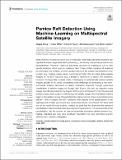| dc.contributor.author | Zheng, Maggie | |
| dc.contributor.author | Mittal, Tushar | |
| dc.contributor.author | Fauria, Kristen E. | |
| dc.contributor.author | Subramaniam, Ajit | |
| dc.contributor.author | Jutzeler, Martin | |
| dc.date.accessioned | 2022-06-15T16:29:12Z | |
| dc.date.available | 2022-06-15T16:29:12Z | |
| dc.date.issued | 2022-04-28 | |
| dc.identifier.issn | 2296-6463 | |
| dc.identifier.uri | https://hdl.handle.net/1721.1/143437 | |
| dc.description.abstract | <jats:p>Most of Earth’s volcanic eruptions occur underwater, and these submarine eruptions can significantly impact large-scale Earth systems (e.g., enhancing local primary production by phytoplankton). However, detecting submarine eruptions is challenging due to their remote locations, short eruption durations, lack of sea surface signature (if eruptions do not breach the surface), and the transient nature of the surface manifestations of an eruption (e.g., floating pumice clasts, hydrothermal fluids). We can utilize global satellite imagery of 10–30 m resolution (e.g., Landsat 8, Sentinel-2) to detect new eruptions; however, the large data volumes make it challenging to systematically analyze satellite imagery globally. In this study, we address these challenges by developing a new semi-automated analysis framework to detect submarine eruptions through supervised classification of satellite images on Google Earth Engine. We train our algorithm using images from rafts produced by the August 2019 eruption of Volcano F in the Tofua Arc and present a case study using our methodology on satellite imagery from the Rabaul caldera region in Papua New Guinea. We potentially find a large number of new unreported pumice rafts (in ∼16% of images from 2017–present). After analysis of the spatial pattern of raft sightings and ancillary geophysical and visual observations, we interpret that these rafts are not the result of a new eruption. Instead, we posit that the observed rafts represent remobilization of pumice clasts from previous historical eruptions. This novel process of raft remobilization may be common at near-shore/partially submarine caldera systems (e.g., Rabaul, Krakatau) and may have significant implications for new submarine eruption detection and volcanic stratigraphy.</jats:p> | en_US |
| dc.publisher | Frontiers Media SA | en_US |
| dc.relation.isversionof | 10.3389/feart.2022.838532 | en_US |
| dc.rights | Creative Commons Attribution 4.0 International license | en_US |
| dc.rights.uri | https://creativecommons.org/licenses/by/4.0/ | en_US |
| dc.source | Frontiers | en_US |
| dc.title | Pumice Raft Detection Using Machine-Learning on Multispectral Satellite Imagery | en_US |
| dc.type | Article | en_US |
| dc.identifier.citation | Zheng, Maggie, Mittal, Tushar, Fauria, Kristen E., Subramaniam, Ajit and Jutzeler, Martin. 2022. "Pumice Raft Detection Using Machine-Learning on Multispectral Satellite Imagery." 10. | |
| dc.contributor.department | Massachusetts Institute of Technology. Department of Earth, Atmospheric, and Planetary Sciences | |
| dc.eprint.version | Final published version | en_US |
| dc.type.uri | http://purl.org/eprint/type/JournalArticle | en_US |
| eprint.status | http://purl.org/eprint/status/PeerReviewed | en_US |
| dspace.date.submission | 2022-06-15T16:22:17Z | |
| mit.journal.volume | 10 | en_US |
| mit.license | PUBLISHER_CC | |
| mit.metadata.status | Authority Work and Publication Information Needed | en_US |
